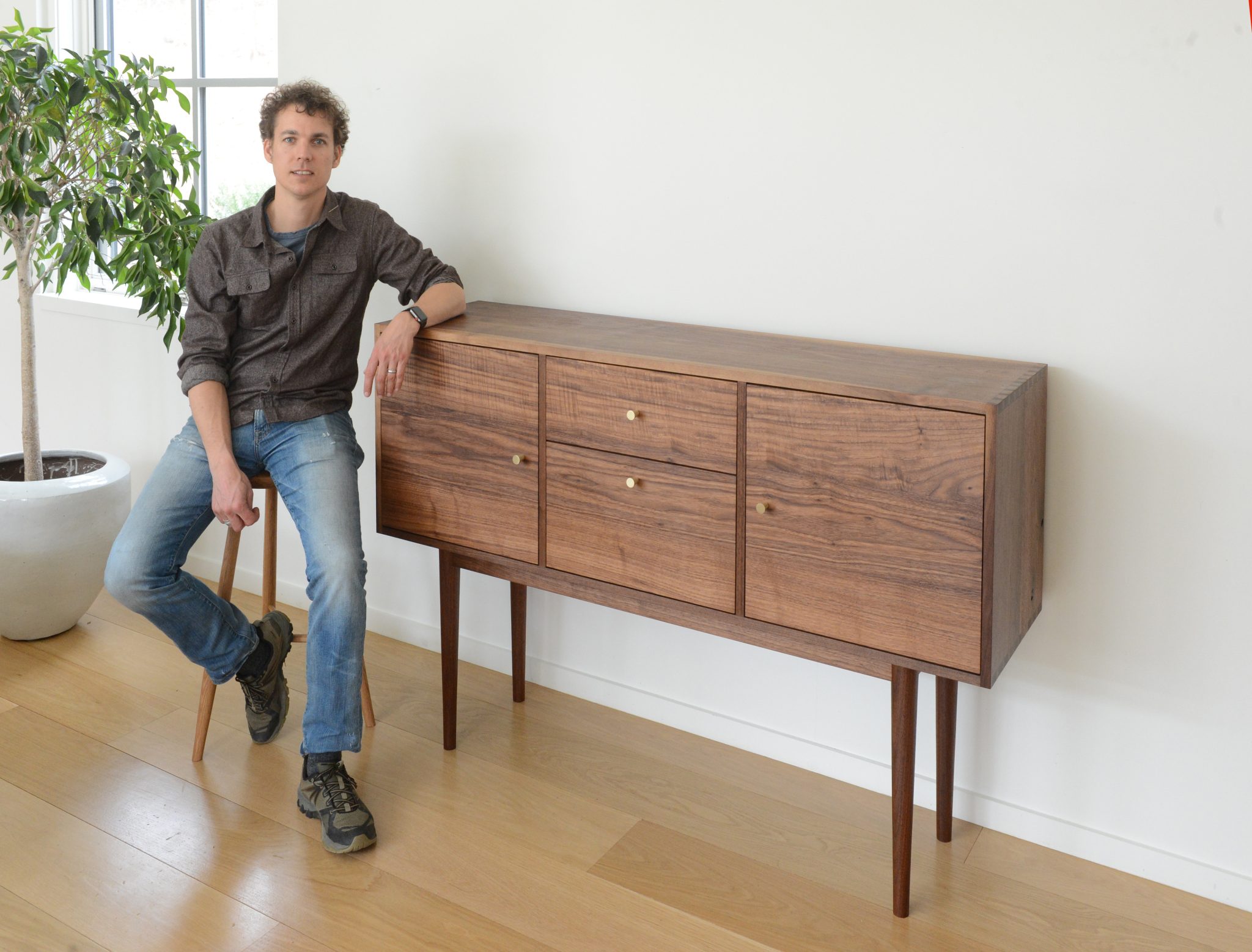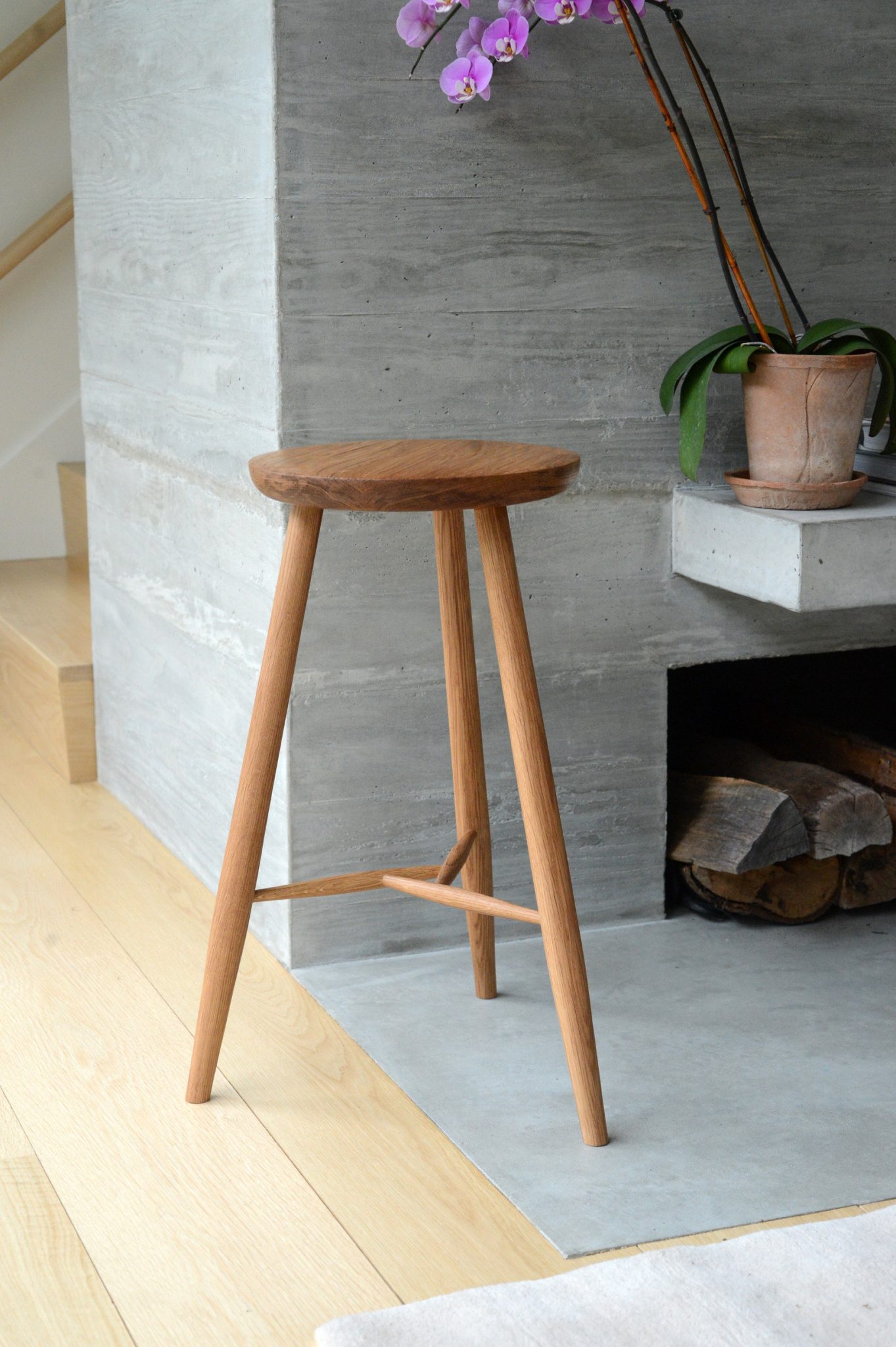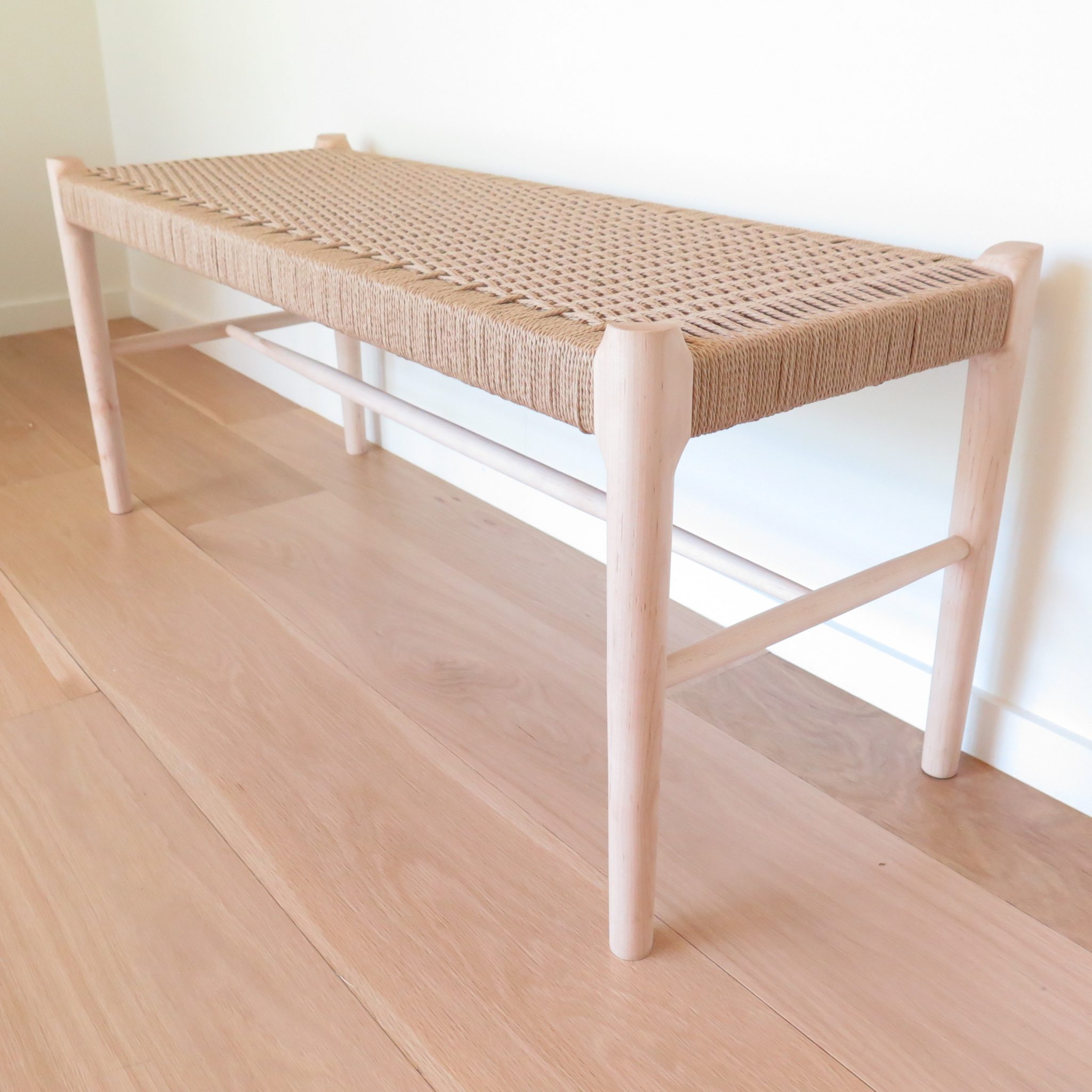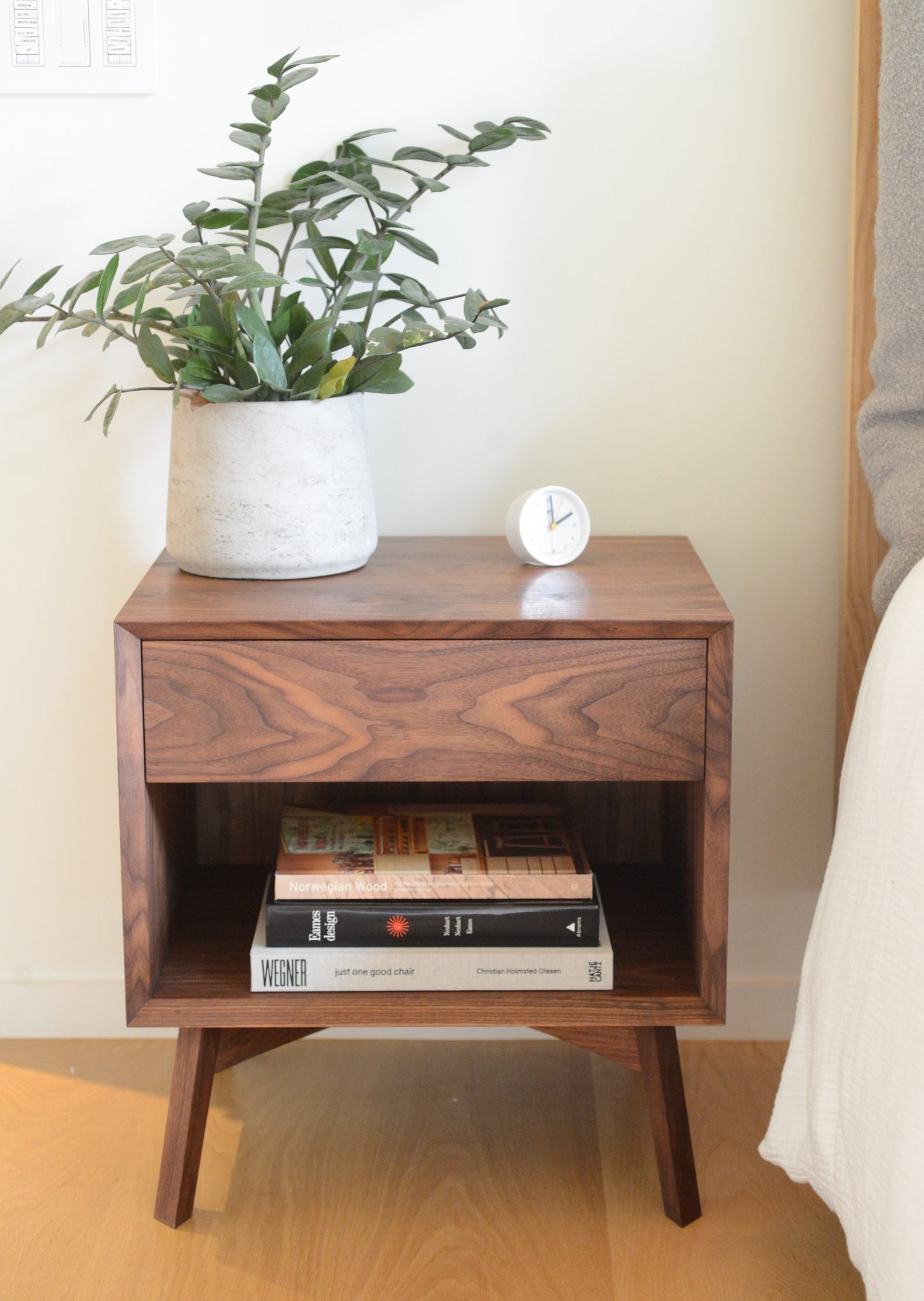
April 27, 2022 by Gabrielle Martin
Meet Hingham born-and-raised woodworker Sandy Weymouth, owner of Sawtimber Woodsworks and founder of South Shore Woodworks.
Weymouth, his wife Jennifer, and their three children relocated from the city to the South Shore suburbs in 2014; they would rent for a year before moving into their current abode just outside historic Downtown Hingham.
“I definitely like the familiarity of living in the town that I grew up in,” says Sandy. “I moved back here already knowing a group of people, which included childhood friends who also moved back, and I [was also] fortunate to know a lot of my parents’ friends who live here. I’ve learned a lot about the history of our town from them.”
“My kids like to hear stories of how Hingham used to be: I tell them about getting grilled cheese sandwiches at Brigham’s, buying candy and toys at Granite’s, and how our dog used to run down to the Sub Galley and get fed pizza crusts by the customers…” Weymouth reminisces fondly. “I miss those places, but love the new spots in town like Nona’s, Bloomy Rind, Salty Days, and Euromart.”
Weymouth’s children are now ages 8, 10, and 12, respectively, and he says “it’s been fun watching them do the same things around town that I used to do.”
Together they continue to make memories around town, including at Sandy’s own childhood home: “My parents still live in the same house on Water Street and we are fortunate to get to spend a lot of time with them. Both [my parents] are very creative, and throughout my childhood they were always working on photography, painting, silk screening, and pottery projects; I can definitely trace the creative urge that I feel back to them.”
Join The Anchor in conversation with Hingham-based woodworker Sandy Weymouth as he discusses his career, his creative process, and honing his craft—plus the exciting new projects on the horizon, like the opening a new workshop, South Shore Woodworks.

Q: So, when did you first develop an interest in woodworking?
A: I definitely remember enjoying shop class in elementary school; after that, I don’t think I picked up many tools until I got out of college and helped my father build a cabin in the middle of the Maine woods. [And] while that was more carpentry than furniture-making, the experience of creating something physical and functional out of a pile of wood stayed with me.
I became interested in furniture when my wife and I started buying it for our apartment after we got married. I would walk around a furniture store looking at things and say, ‘I bet I could make this.’ Of course, I had zero skills at that point–but the desire to make furniture in a style that appealed to me was growing. Woodworking is not an easy thing to do while living in an apartment in Boston; the lack of accessible shop space to use outside of normal work hours is hard to find.
I got a craving in 2013 to start making things and searched for woodworking classes in the area. I eventually signed up for a box making night class at the Eliot School in Jamaica Plain and there I learned about a more in-depth program at the North Bennet Street School (NBSS) in the North End. NBSS is the oldest trade school in the country and they offer a variety of classes in woodworking, locksmithing, carpentry, piano technology, violin making, and jewelry making. In a world that is focused so much on technology and automation, it was encouraging to find a place that still focuses on making things with your hands.
I decided to try woodworking and signed up for a 3-month intensive class on furniture making. I loved it so much that I subsequently signed up for the 2-year full-time program in NBSS’s cabinet and furniture making department. The students in my program ranged from high school graduates, to people like me, in career changes, to retirees. After graduation I started my woodworking business, Sawtimber Woodworks.
Q: Can you tell our readers a little bit about your background and education?
A: I graduated from Bates College in Maine with a geology degree and worked in environmental consulting for five years before going back to school at the University of New Hampshire to get a graduate degree in environmental engineering.
I worked as an environmental engineer for another nine years before going back to school again, this time at the North Bennet Street School (NBSS) in Boston; it was there where I started my career as a woodworker after graduating from the two-year Cabinet and Furniture Making program in 2018.
Q: What made you decide to change careers?
A: I loved working [as an environmental engineer] because much of that time was spent doing fieldwork! I have never enjoyed sitting at a desk for extended periods of time. My last job as an environmental engineer was at a remediation company, using innovative technologies to clean up contaminated properties. The work was never boring and sadly, there was a never-ending supply of jobs coming through the door; however, after my wife and I began having children, I started to worry about the amount of chemicals I was exposing myself to at work as we were investigating, testing, and remediating some pretty nasty contaminants.
I realized I wanted to leave that job and decided it would be a good opportunity to try something completely different.

Q: And what was your experience at NBSS? What did your woodworking education look like?
A: NBSS was an amazing place to learn furniture making. The teachers are extremely knowledgeable and the program is one of the best in the country. The curriculum focus is on 18th and 19th century American-style furniture—which, while not my personal style, is some of the hardest furniture to make. If you learn the joinery and finishing techniques of this style, you can build anything.
The NBSS graduate network is also a very valuable resource, and I am continuing to learn from former students and teachers that are still there; I also feel lucky to be continuously learning in ‘the Internet Age,’ as there is a vast amount of valuable information online when I can’t figure something out.
Q: What’s your favorite thing to build, create, or design?
A: Up until this point, I’ve been somewhat limited as to what I can build due to the size of my [at-home] woodshop; I’ve been making a lot of smaller pieces like side tables, coffee tables, stools, and benches. The new shop I am currently putting together will have much more space to build larger pieces, like dining room tables, [which] I get a lot of requests [for].
My favorite type of furniture would have to be the chair, although I have not built that many; chairs were what really got me interested in furniture-making, and I hope to focus more on them in the coming years.
While not my only focus, I am a huge fan of minimalist yet functional design, which is a hallmark of the Scandinavian aesthetic. The expression ‘less is more’ by architect Ludwig Mies van der Rohe sums up this approach nicely: Scandinavian furniture often uses lighter woods like white oak, maple, or birch to match the light interior designs the style is known for.
In comparison, some of the more traditional furniture styles, [like those] you might see in a high-end antique store in Boston, have ornate carvings and painted finishes that do not add anything to the functionality or durability of the piece and are solely for the visual effect.
My goal is to build furniture that you can use, rather than something that sits in the corner untouched like a piece of art. For this reason I also am a fan of Shaker-style furniture, which also focuses on minimalism and functionality.
Q: How would you describe the furniture you create in 5 words or less?
A: Well-designed, functional, hand-crafted.
Q: What is your creative process, from idea conception to build?
A: This depends on whether I am making a spec piece or a commissioned piece for a client: with a spec piece, I am designing something that will represent my aesthetic with the hopes of better defining my brand and eventually selling the piece to a client. With a commissioned piece, I am designing something often with some input from a client who is looking for a particular style and size to fit his or her home; however, even with commissioned pieces, I try to stay within my aesthetic lane.
At NBSS, they teach you to draw out all of your furniture designs on paper, often at full-scale. I learned computer aided design (CAD) software in my previous career, so I prefer to do all of my drawing on a computer; I find it more effective to present ideas to clients in digital format. Once the design is set, I select the wood type and head to the lumber yard.
I only buy rough lumber produced in a sawmill, which makes it difficult to tell what the actual finished wood will look like until I mill it back in my shop. The milling process is when you get to see the true color and grain of each piece. Sometimes I’m not happy with what I picked out and have to head back for more.
If it’s a furniture design I have never made before, there might be some trial and error involved in figuring out the joinery, which is how the pieces of wood are joined together. Once the piece is constructed it is sanded and then finished, usually with a clear coat of oil or water-based finish depending on the intended use of the piece.
Q: Where do you get the wood you use?
A: Sadly, a lot of hardwood lumber yards have disappeared. I usually have to drive at least an hour to find a good selection of the rough-cut boards needed for furniture making. One service I would like to offer in the future is the use of local wood from trees that either fall down or are taken down for other reasons by clients.
I have gotten a handful of requests from people who just lost a tree and want to use the wood rather than see it turned into chips or fire wood; the process, unfortunately, is not as simple as cutting the wood up and building with it as it has to be properly dried first, either in a wood kiln over a period of weeks or air-dried over a period of years depending on the thickness.
There are several people who provide the sawmilling services on the South Shore, to cut the wood into usable lumber, but the drying process is more complicated. The exception is bowl turning, which often uses ‘green’ wood from freshly cut trees; while I have done a little bowl turning, there are some far more talented turners in the area that you can find at the local craft fairs.
As I develop my larger woodshop, I would like to be able to offer both the sawmilling and the drying process someday, so that clients can turn their beloved felled oak or walnut trees into furniture.

Q: How does sustainability contribute to/play a role in your work?
A: I spend a lot of time walking through the woods and it’s not lost on me that my profession relies on cutting down the trees that make up those woods. I could obviously switch to making furniture out of other materials like metal or plastic, but part of why I got into furniture making was my love for the look and feel of natural wood.
The use of reclaimed or recycled wood is an obvious pathway towards sustainability; however, that is not easy for a solo woodworker, compared to a large company like Restoration Hardware that can source those materials from all over the world. There just isn’t a huge supply of local reclaimed wood around here, and shipping small quantities of it across the country isn’t exactly environmentally friendly.
As I grow my business I would like to use more reclaimed wood as well as wood from local trees that normally would be chipped or burned in your fireplace; in the meantime, I feel like my goal of making well-constructed furniture out of hardwood materials is making my craft more sustainable. My furniture may be more expensive than what you can find in the big box furniture stores, but it will last five times as long due to its construction. This, in turn, uses fewer materials over time, as you don’t have to keep replacing pieces that break. Even if my furniture does happen to break one day, it is a lot easier to fix something made from hardwoods than a piece made of particle board that starts to disintegrate with heavy use.
My goal is to make furniture that will be passed on to grandkids, although I am well aware that not everyone will want his or her grandparents’ furniture when the time comes!
Q: What’s something you wish more people knew about woodworking?
A: There is a lot of work that goes into a hand-made piece of furniture. You get what you pay for in the longevity of the piece that justifies the price. The joinery used in factory-made furniture is not as strong as the joinery in hand-made pieces and the materials they use are not as durable. Also, the attention to details that you get with a hand-made piece is just not possible in a piece produced in a factory.
Q: What are some of your favorite things to do or hobbies?
A: Besides woodworking, which I love to do, I try to spend as much time as possible outdoors hiking, mountain biking, and fishing.
If I had to pick a favorite place, it would be on a trout stream.
It has been fun to see my kids get interested in making things, and we’ve been working on 3D printing and CNC machining projects at home. I’m definitely jealous of the engineering and design technology they have at their fingertips that I didn’t have as a child.
At the end of our interview, Sandy reflects on his latest project: opening a brand new, larger woodshop in the neighboring town of Weymouth: “Prior to finding this particular spot, I had searched for over a year on the South Shore for available spaces, and found that the majority were windowless warehouses in industrial parks. When I walked into this building in Weymouth, I immediately knew I had found something special.”
Weymouth’s new studio space will feature hardwood floors, lots of natural light, room for expansion, and an interesting history. “The previous business that worked there was a third-generation company manufacturing conveyor belts for the tobacco industry,” he shares. “Two of the huge vulcanizing presses they used to join lengths of belt material together are still there!”
The new woodshop will be called South Shore Woodworks and will operate similar to a Maker Space, where experienced woodworkers can rent shop space on an annual basis to save on costs and have access to a larger space and more machinery.
“There will be room for seven makers, including myself, and the shop will have a shared office and lounge, private bench and storage space, a finishing room, and a 3,700 square foot machine room,” he shares. “These types of cooperative spaces are great for woodworkers trying to start their businesses and who want access to more machinery and space at a lower cost; they also are good for experienced hobbyist woodworkers who are tired of working out of their basements or garages.”
Another benefit of a space like this? “The collaboration that can happen between members with both knowledge sharing and work sharing. Operating under the same roof with woodworkers with different backgrounds and experiences is extremely helpful when it comes to problem solving a difficult project. Also, makers like myself may get through most of the year working solo, but occasionally a job comes through the door that requires more than one worker due to a time deadline or the complexity or size of a job. Having the ability to easily share extra work with other members on a short-term basis is an efficient way to operate.”
Sandy says he is hoping to have South Shore Woodworks up and running this summer.
For more details visit https://sawtimber.com. You can keep up with the workshop on Instagram @sawtimersandy


Hi Gabrielle,
There is a euphoric feeling that comes with woodworking. It’s so enjoyable, but can be a bit confusing if you don’t know what to do or where to go. I never thought of it as a career though, that’s a unique angle. It’s something to consider though. I want to encourage everyone to try woodworking at least once outside of school prerequisites. Don’t know where to start here is my free gift to you www. Freeguidetowoodworking.com Enjoy. Thank me later 😀
Congratulations, Sandy! This is exciting!
Awesome, Sandy. So glad you are bringing your skills in Hingham. Best of luck with the launching.
Your
design and craftmanship are wonderful Sandy. We look forward to seeing your new digs in Weymouth – great idea.